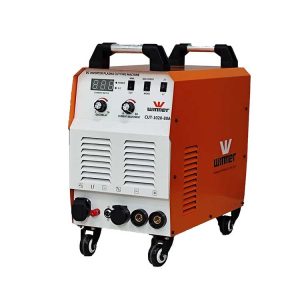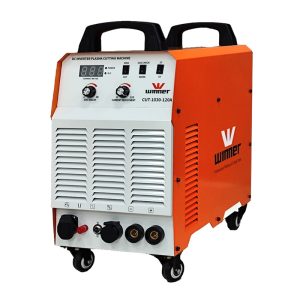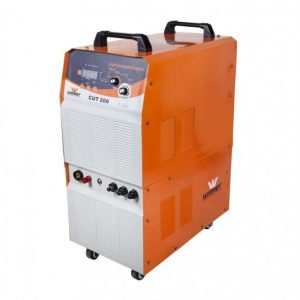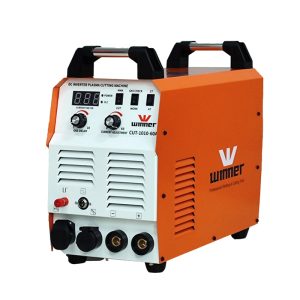Showing all 4 results
0 to 100 plasma cutting machine Application, types, price, working method
Plasma cutting is a process that evolved from plasma welding in the 1950s and was designed to precisely cut thin and thick materials. However, this method was not accepted by manufacturers and builders until the 1970s due to the cost of the system and required gases and lack of knowledge about this process. There is now a wide range of plasma cutters. In this article, we are going to provide you with all the essential information you need about high performance plasma cutting machine. So stay with Winnertools until the end of the article to add to your treasure of information.
What is plasma cutting?
Plasma cutting, sometimes also known as plasma arc cutting, is a melting process in which a jet of ionized gas at a temperature of more than 20,000 degrees Celsius is used to melt and eject material from Cut is used.
In fact, plasma cutting is a process in which a fast jet of hot plasma cuts electrically conductive materials such as steel, stainless steel, aluminum, brass, and copper. Plasma cutting is mostly used in automotive repair operations, industrial construction, salvage and scrap metal.
Before purchasing any piece of equipment, you should have a basic understanding of what a plasma cutter does and how it does it, to ensure that you have the wherewithal and ability to use the equipment safely.
How does plasma cutting work?
Plasma is the fourth state of matter. While we usually only refer to the three states of matter, solid, liquid, and gas in general, plasma is the state that exists when heat and vapor combine, and the gas becomes ionized and electrically conductive.
Plasma cutter or plasma cutting machine (in English: Plasma cutter) can be used in different types of businesses that need to cut metals with different thicknesses to carry out their industrial productions. But first, let’s talk about how the plasma cutting method works exactly and in what industries is it used?
During the cutting process, an electric arc is struck between the electrode (cathode) and the workpiece (anode). Immersing the electrode in a cooled gas nozzle causes the arc to contract, forming a narrow, high-temperature, high-velocity plasma jet.
When the plasma jet hits the work piece, a recombination happens and causes the gas to return to its original state, during which we will see the release of intense heat. This heat melts the metal and causes the gas flow to take it out of the cut. Usually argon, argon/hydrogen or nitrogen gases are used in plasma cutting.
The plasma arc can cut a wide range of electrically conductive alloys including plain carbon and stainless steels, aluminum and its alloys, nickel alloys and titanium. This technique was originally developed to cut materials that could not be cut by the oxy-fuel process.
High tolerance plasma arc cutting (HTPAC) is an important development in plasma arc technology. This process gives better accuracy on materials less than 12 mm thick and can be a low-cost alternative to laser cutting.
In what industries is plasma cutting used?
All types of petrochemical and refinery industries
Power plants
Automotive industry
Military and defense industries
Shipbuilding
Application of plasma and plasma cutting machine
The various uses of plasma cutting machines may surprise you. Although they are a useful tool for most industries, they are also somewhat useful in several other areas of productivity.
Artistic Use Of Plasma
Many artists create art by cutting metal, and of course, the utmost precision and delicacy should be used in these cuts so that the best lines are cut without warping or bending the metal.
Another use of plasma cutters is to create complex molds and stencils that allow other artists and creatives to create their own works of art. Therefore, this tool is considered an essential tool in the world of arts and crafts.
Commercial Plasma Uses
A plasma cutter is a good tool for a plumber to have in her arsenal. You can save time by cutting pipes with this machine. At the same time, the accuracy of the cut plasma tubes is superior to any manual saw cut, and makes the tubes fit and stick cleanly without frayed edges.
Contractors use plasma cutting for all building elements that require sheet metal. As long as you have access to a power source, you can do the cutting directly on site.
Ships are usually built in a shipyard by shipbuilders specializing in naval engineering. These shipbuilders use plasma cutting machines to measure the steel sheet needed to build the walls, deck and hull.
Refrigeration and air conditioning companies use plasma cutting to cut metal for the installation, construction and repair of metal ducts without the need to go back and forth to the workshop.
In the manufacturing industry, precise cuts can be made in bulk with a CNC machine and a plasma cutting machine and used together. Multi-axis cutters also make seam welding better. The plasma cutter in the workshop industry provides the possibility of cutting repetitive patterns with accuracy and speed.
Auto dealers use plasma cutters to make exhaust manifolds for turbo conversions, as well as to remove damaged parts of the car before installing other parts. Plasma cutting can also be used to remove rust from the car body.
Different types of plasma cutting machine
Choosing the type of plasma cutter depends on the application you are considering. Portability, productivity, and usability are some of the considerations to consider when choosing a device. The high speed, accuracy and low cost of the plasma cutter have led to its use in many projects.
Plasma cutters operate with an air compressor that can be built-in or purchased separately. Pricing varies significantly between them, but without a doubt, convenience will determine which type of plasma cutter is best suited for your use and job needs.
When choosing a device, it is important to understand that there are differences between units manufactured for industrial and domestic use. Without proper training, buying and using the wrong type of cutting machine can waste your time and money in the long run.
Because of their portability, small die cutting machines allow many contractors and tradesmen to use them instead of bringing work to their own workshops or paying a premium to have someone else cut them to specific sizes.
1- Automatic plasma cutters
Automatic plasma cutters are usually large units capable of large jobs. Industrial production lines where large steel cutting projects occur are where these cutters can be found. Automatic cutters are computer operated and the control head is usually mounted on a table.
In the case of these types of plasma cutting machines, it is essential to know the maximum sheet size required, the maximum sheet thickness, the number of sheets you need to cut, the amount of work space and the tools required.
CNC plasma cutters or Computer Numerically Controlled cutters are also run on software. By installing the correct unit in the right place, the ratio of cost to accuracy is maximized and waste is minimized.
The number of automatic options and choices on a CNC machine alone is impressive, and there are as many variables and parameters as there are machines, so choose wisely before starting a new job.
Types of CNC plasma cutting machines
There are different types of CNC plasma cutters. The three main configurations of these units are:
2D/2 Axis
This machine is the most common type of CNC plasma cutting machine and produces flat profiles with cut edges at 90 degrees to the surface of the material. With this machine, metal plates can be cut up to 150 mm thick.
3D/3+ Axis
This machine is also capable of cutting flat profiles, but instead of 90 degree angles, it can rotate on a third axis, which allows it to cut edges at angles that are not 90 degrees. A 30 or 45 degree cut allows parts to be welded together immediately without secondary processes such as grinding or machining, thus reducing costs.
Tube and Section
This device is used in processes such as piping, piping and other long sections of material. The cutting head is usually fixed but may tilt or rotate depending on its configuration. This movement can allow more angles to be cut.
2- Manual plasma cutters
Hand-Held Systems Hand-held devices are ubiquitous and provide high cutting current or amperage. Handheld plasma cutters are suitable for lighter work such as turning or cutting smaller pieces of metal. It is possible to use these devices in garages, car repair shops, hobby shops and even homes.
Conventional plasma
All hand-held units from normal plasma are used in all hand-held units. Conventional plasma cutters use shop air instead of plasma gas, and the shape of the arc is determined by the tip of the nozzle.
High Definition Precision Plasma
Precision plasma units are engineered to produce the highest quality cuts possible for industrial applications. This system may use several gases such as a mixture of hydrogen, argon, nitrogen or oxygen, nitrogen or compressed air. An accurate plasma arc is about 40-50 kA/square inch.
Depending on the type of work and unit, arc initiation methods are different. In some, arcing occurs when the tool contacts the workpiece. Other cutters use a high voltage or high frequency circuit to initiate the arc.
Units used near sensitive equipment such as computers and other electronic devices arc by blowing the nozzle forward when the plasma gas begins to flow or by discharging capacitance to the primary circuit through a silicon controlled rectifier. rectifier) start.
How does a plasma cutting machine work?
Plasma cutting machines are becoming a common tool in many industries such as metal fabrication, construction and automotive repair. This tool is capable of cutting a variety of metals including steel, copper, brass and aluminum by producing a very high temperature electrical channel of ionized gas called plasma.
This tool is capable of cutting a variety of metals including steel, copper, brass and aluminum by producing a very high temperature electrical channel of ionized gas called plasma. The device then uses the plasma of this electrically conductive gas to transfer energy from the power source to a conductive material and allows it to be cut with very little or no resistance. This method results in a clean and fast cutting process.
A plasma arc is initiated when a gas such as oxygen, nitrogen, or argon passes through a small nozzle hole inside the torch. An electric arc generated from an external power source enters this high-pressure gas flow and results in the creation of a plasma jet. The plasma jet can reach temperatures of 40,000 degrees Fahrenheit and cut through metal as easily as a hot knife cuts through butter.
Do you need gas for plasma cutting?
Gas is required to work and generate plasma in a plasma cutting machine. As mentioned, the most popular gases used are oxygen, nitrogen or argon. Some plasma cutting machine systems have multi-gas features, meaning that a variety of gases can be used for different applications. Depending on the type of metal that the machine cuts; Different gases are used.
Oxygen has become the standard gas used when cutting steel because it offers the fastest cutting speed of any plasma gas.
Nitrogen is the best choice for cutting aluminum and stainless steel and can provide excellent cutting quality.
Argon is ideal for cutting thick stainless steel and aluminum; Because the hottest plasma is burning.
For a more economical choice, clean dry shop air is recommended and passes through mild steel and stainless steel as well as aluminum.
How hot does a plasma cutter get?
The heat of a plasma cutting machine can reach a significant temperature of 25,000 degrees Celsius. To understand this temperature, it is better to know that it is much hotter than the surface of the Sun because the temperature of the surface of the Sun is 5505 degrees Celsius.
Safety is very important when using a plasma cutter. Looking directly into the flame can permanently damage your eyes. Also, contact with flame quickly destroys skin, muscle and bone. It is among the duties and necessities to choose the right PPE (personal protection equipment) for the workplace. This equipment can include helmets, safety shoes, gloves, eye protection and respiratory protective equipment to ensure the safety of workers.
Keep in mind that often, using the maximum heat setting of a plasma cutter is unnecessary, and doing so consumes a significant amount of electricity. Our advice is to keep it at the lowest temperature if possible and not to work with it for a long time. Both for your own safety and to reduce your electricity bill, it is better to use the device in short intervals!
Can a plasma cutting machine cut paint?
Yes, a plasma cutter can cut through painted metal, however, it is important to have a tight fit on a clean piece of metal as close as possible to the area you are working on and intend to cut. needs.
A plasma cutter will only work if there is water or moisture in the machine’s air compressor and the air pressure is not correct. If there is too much air, the plasma can potentially blow up the device, and if there is too little air, you will have trouble cutting.
Manufacturers should be aware that even the smallest amount of moisture can have a negative effect on the tool. If the machine runs erratically while cutting, moisture is most likely the cause. Use quick-release disposable air filters in the base of the instrument to ensure dry compressor air.
What metals does the plasma cutting machine cut?
Plasma cutting machine can only be used for metals and alloys that are conductive. These metals are:
Soft steel
stainless steel
aluminium
copper
brass
Cast iron
Titanium
Monel (a group of nickel alloys consisting of nickel and copper)
Inconel (a group of nickel-based superalloys)
The melting point of some of these metals makes them difficult to work with because the cutting capacity of the machine decreases as the electrical conductivity of the metal increases, resulting in an uneven or jagged edge.
Plasma cutting machine price
Prices for plasma cutters can vary from £800 to £45,000. This is a huge price range that depends entirely on the size of the machine, be it a handheld machine or a larger industrial machine. But in any case, the quality and required features should also be considered.
There are plenty of cheap plasma cutters on the market starting at £130, however, while these machines may have impressive cuts, it won’t be long before you need to replace them. Reputable names that are leading manufacturers of welding and cutting equipment are much more reliable, which is reflected in the plasma cutting capabilities.
The plasma cutting machines offered at Winner Tools (winnertoolsco.com) are all high power, user friendly and of the highest quality. We can also offer a range of delivery options.
Safety requirements when using a plasma cutting machine
People who work with this tool say that using a plasma cutter is like holding a lightning bolt in your hand, so treat it accordingly. As useful as this device is, it can undoubtedly cause serious harm if used incorrectly. Some of the safety equipment recommended by professionals that you should use when working with a plasma cutter include:
A plasma shield/helmet to protect your face and eyes
A welding beanie to protect your hair from sparks
A welding jacket to protect your arms and torso from sparks
A pair of welding gloves to protect your hands from the plasma arc
A pair of utility jeans to protect your legs from sparks
A pair of tightly laced boots to protect your feet from falling pieces of metal or molten steel.
a fire extinguisher
Appropriate eye protection is required to prevent injury from throwing debris or eye arcs from exposure to radiant energy. Different filter lenses are necessary that are designed to counteract the arcing of the eyes caused by exposure to radiant energy.
When it comes to safety equipment, eyes aren’t the only concern. To prevent burns from sparks and hot metal, we recommend gloves, aprons and leather jackets.
It goes without saying that all work done with the plasma cutting machine must be done in a clean environment free of any flammable liquids, substances and gases within a radius of at least 6 feet. Sparks can fly much farther, so make sure the workplace is free of such fire hazards.
Potential safety hazards associated with working with a plasma cutting machine
Every metal worker knows that cutting metal can be dangerous. But when cutting metal using a plasma cutter, the risk reaches its highest level at the beginning of the work and decreases to some extent after the first cut.
When starting a new cut, there is always a chance that the metal will splash up until the plasma arc completely penetrates the steel you are cutting. This is commonly referred to as blowback (a process in which gases expand or move in a direction opposite to the usual direction, especially through pressure escape or delayed combustion).
This is more likely to happen in thicker metals, where for only a fraction of a second the sparks are significant enough to cause severe damage. Burns to the face, head, hair, and clothing are all a possibility, so wear protective clothing from the start.
Safety boots are essential for anyone cutting significant sections of metal, as the cuttings can crush your feet when they fall. Boots can also protect you from sparks and burns if you tie them properly and tightly around your ankles.
Important points when using a plasma cutting machine
To obtain the best cutting quality, it is necessary to use the right tool with the right amperage for the right metal piece. While skill is essential, the most skilled craftsman will produce a low-quality cut if their tools are of poor quality.
Before pulling a handheld plasma trigger, let’s share some tips and tricks to make the job easier and keep your fingers and toes healthy and protected. These points include:
For more stability, hold the hand you are cutting with your non-winning hand.
Before starting, practice your cuts and trace the pattern a few times.
Do a test cut on a similar piece of metal to make sure you are using the right amperage and speed
On thicker material, pause to remove the end or rotate the torch tip
Tilt the cutter at an angle of 30 or 40 degrees to shave the edges of the cut.
Roller spools make cutting straight edges easy.
Circular reels cut circles of different sizes each time.
Automatic cutters are completely different and more complex than manual units, and the technique used in these plasma cutters requires a certain science and expertise. Some tips for using the automatic plasma cutting machine:
Replace consumables regularly to ensure you always have the cleanest cut.
Match the power level to the thickness of the material to get the best cutting quality.
Maintain proper suspension to avoid any damage to the torch.
Reduce scum and scum on the molten metal surface by using proper power settings, torch height, and cutting speed.
Hire a knowledgeable and trained person to prepare the CAD plan.
Buying a plasma cutting machine from Winner Tools
3 types of plasma cutting machines are offered in Winner Tools, the largest specialized brand of welding and cutting tools in Iran:
1- Plasma cutting machine model CUT 120
2- Plasma cutting machine model CUT 200
3- CUT 60 model plasma cutting machine
To learn more about the features and specifications of these cutting machines, you can click on any of them to be directed to the corresponding page. If you need more information about plasma cutting machines or regarding Winner products, call 02166705010. Rest assured that one of our highly knowledgeable and experienced members will be available to provide expert advice and guidance.




